
Comparing classic muscle cars to their contemporary counterparts definitely evokes a sense of nostalgia for what has passed: automotive design as a work of art. Things like bench seats and gull-wing doors were once considered beautiful facets of older cars. But with newer cars like the Ford Flex and BMW i3, it’s easy to see that what was once an avenue for creative work has now been overrun in favour of utility and technology.
Some modern vehicles, particularly in the performance realm, are prone to taking creative risks just like their classic predecessors. In fact, it seems that performance vehicles are returning to the old-fashioned aesthetic appreciation. Sure, the Chevy Stingray and Mercedes-Benz SLS AMG are incredibly powerful, but their biggest highlights seem to be design-related, as seen in the bold creases and arching lines punched into the sheet metal. They also channel some of the creative intricacies of their classic counterparts, like latticework side vents and chrome strikethroughs.
To visualize this creative resurgence, here’s a light juxtaposition between some of the coolest classic cars and their modern successors.
1. Ford Mustang
The Ford Mustang was introduced in 1964, unintentionally inspiring a movement of sport-oriented automobiles with long hoods and short rear decks that would soon be dubbed “pony cars.” The muscular, squared-off hood featured round headlights embedded at the front, connected by a chrome strikethrough that became standard for successive ‘Stangs. It sought hardtop competition from the Chevy Camaro and Pontiac Firebird which were released by General Motors in 1967. This automobile became the supernova of American muscle cars, and has remained that way ever since.
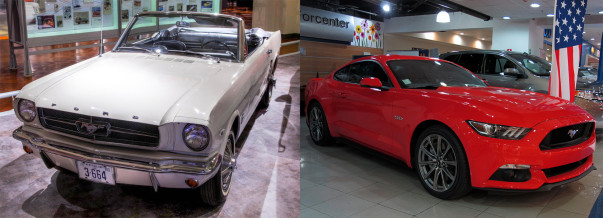
1964 Ford Mustang (left) and 2015 Ford Mustang (right)
In 2015, however, the Ford Mustang is a long way from home, finding itself outfitted with sleek accent lines embedded into a more rounded and smooth sheet metal that definitely lines up with modern automobile architecture. Classic features like aggressive headlights and hood inlays are still incorporated into the vehicle’s design strategy, but now they flow through the vehicle, and feel a bit more pronounced. They also share the space with a restyled mesh grille that is more rounded and feels very distant from where it began. Overall, the new Mustang bears little resemblance to its original form, save for the optional racing stripe down the hood, which has been around since the beginning.
2. Chevrolet Corvette Stingray
First available in 1963 as the Corvette C2, this two-door sports car was conceived as a futuristic fastback and took incredible risks in creative design. For one, its divided rear window was the most unusual styling element in sport vehicles of the time. But what made it really stand out were the doors that cut into the roof, hidden headlamps and faux vents in the hood. Interior aspects like the leather trim and bucket seats were standard for performance vehicles at the time, but the dash featured a variety of round gauges that were accompanied by a vertically-oriented centre console with a large clock and a radio dial.
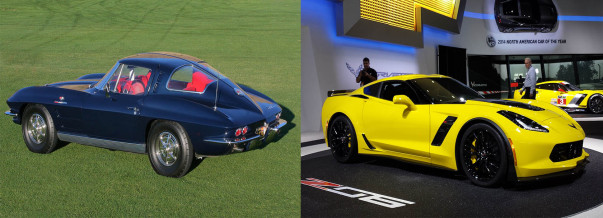
1963 Chevrolet Corvette C2 (left) and 2015 Chevrolet Corvette Stingray (right)
The new Corvette Stingray is built with tons of aluminum and even some magnesium, resulting in a vehicle that is surprisingly lightweight. The front end is definitely inspired by the newer Ferraris, boasting a large vent embedded into the unique carbon fibre hood, as well as performance-oriented front fender vents. And though the classic sport theme is largely retained in the flowing lines and dual-mode exhausts at the back, this car somehow blends perfectly with modern improvements. It feels like the clear-cut wheel wells, sweeping roofline and cutting rear-end flow seamlessly into each other, providing a tenacious appearance for Corvette aficionados. When it comes to aesthetics, it doesn’t get much better than the Stingray.
3. Mercedes-Benz 300SL/SLS AMG
This iconic two-seater was first introduced in 1954 with arguably the boldest exterior design of its time. The entire coupe was made of steel and featured one of the most recognizable bodies in the automotive world, starting with distinctive gull-wing doors that brought some serious charm. This, along with the first-ever production of fuel injection on the front-mounted 3.0-litre straight-six engine, solidified this car as a landmark in automobile production.
Impressively enough, the 300SL also held the title for the world’s fastest top speed. Right behind the front wheels was a pair of gill-style heat extractors with a chrome strikethrough, while the back rounded out with small rectangular taillights on either side of the curved rear end. Softer creases adorned the substantially long hood for a look that could only be considered timeless.
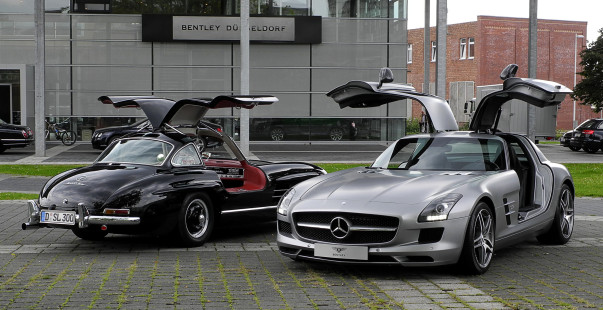
Classic Mercedes-Benz 300SL (left) and the current SLS AMG (right)
Today’s Mercedes-Benz SLS AMG, a spiritual successor to the 300SL, is produced in low quantities, with the same gull-wing doors and new cutting-edge technical components – making it one of the most collectable Mercedes-Benz models of our time. The all-aluminum grand tourer veers away from the rounded 1954 model with a squared-off body, but the bonnet front vents and latticework side vents definitely evoke the 300SL’s sporty feel. Sweptback headlamps replace the round headlights, but the grille strikethrough remains, framing Mercedes’ signature star centre. There’s also a spoiler at the back for improved style and aerodynamics – both of which are necessities in modern sports cars.
4. Dodge Charger
Introduced mid-season of the 1966 model year, the two-door Dodge Charger fastback defined the muscle-car era with a well-designed front-to-black flow that brought sleek continuity to the muscularly-built framework. A unique “electric-shaver grille” with rotating headlights completed the front end within one cohesive unit, making this mid-size automobile stand out amidst aesthetic revolutionaries of its time. The sweeping roofline flowed into the back end, featuring a full-width six-lamp taillight with chrome “CHARGER” lettering embedded on top. Sport sophistication was evident in the cabin as well, with a full-length console stretching from front to back, while being situated between four vinyl-lined bucket seats.
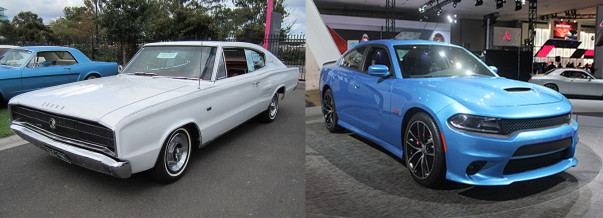
1966 Dodge Charger (left) and 2015 Dodge Charger SRT 392 (right)
The current Dodge steers away from the retro muscle car cues that recent years have seen incorporated for nostalgia’s sake. Instead, the Charger clearly embodies all that is modern, while still retaining creative license, ridding itself of the menacing grille design and opting for a low-key crosshair grille in-between projector headlights. The headlights do exhibit a retro finish with distinctive C-shaped LED daytime running lights, but for the most part, the new Charger is rounder and softer, but less intimidating than the original version. At the back are the quintessential LED racetrack rear lights with the same chrome “CHARGER” lettering – a much-appreciated throwback to the 1966 classic.
5. Jaguar E-Type/F-Type
Initially introduced as the Jaguar E-Type (XK-E), this grand tourer was designed as a rear-wheel-drive two-seater coupe or convertible for the especially upscale drivers of the 1970’s. The luxury car featured an extra-long hood with the cabin situated towards the back for an up-close and personal handling of the rear-situated engine. Glass-covered headlights accompany the small “mouth” opening at the front, while dual exhaust tips sprout just under the number plate at the back for a posh and muscular overall look. Fittingly so, as this automobile once adorned a custom Union Jack paint job, when it was used as a promotional vehicle for the 1997 picture Austin Powers: International Man of Mystery.

1968 Jaguar XTE (left) and 2016 Jaguar F-Type (right)
This year’s Jaguar F-Type, the evolutionary successor to the 1970’s grand tourer, is still a rear-wheel-drive two-seat coupe/convertible that now relies on a new design language for an evolutionary creative direction. Despite relying on the classic sports-car formula, the new Jaguar is shorter and taller, with a large grille adorning the front fascia – allowing aficionados to forget that oval, open-mouth shape from the past. Its origins haven’t totally been forgotten though, as the round taillights and flowing roofline are the perfect call back to the classic E-Type. New this year and constituting a truly remarkable advancement in automobile design are the missing door handles, considered to disrupt the sleek continuity of this vehicle. Instead, they pop out of the doors at an angle with a push of a key fob.
6. Chevrolet Camaro
After a few years of initial development and some heavy inspiration from the Dodge Charger, the 1969 Camaro became a beautiful pony car to take on rivals, like the Ford Mustang, in a battle for aesthetic dominance. This auto offered a sporty look that integrated a fresh grille with the now-signature heavy “V” cant and deeply inset hidden headlights for a truly intimidating look from the front. Overall, the Camaro took on a much more aggressive look for this model year. However, the heavily creased and muscular appearance was soon left behind in the succeeding years in favour of more rounded and smooth lines.
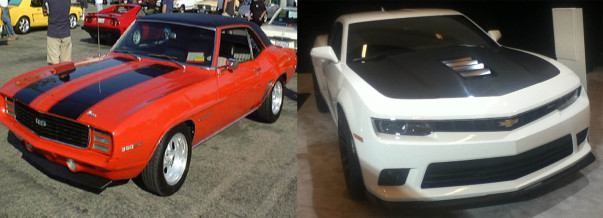
1969 Chevrolet Camaro (left) and 2015 Chevrolet Camaro SS (right)
The 2015 model is just as sleek as its original counterpart, but with the sophistication and balance that has developed over the years of fine-tuning and adjustments. The new Camaro is athletic and dapper, with its muscle-car attitude channeled through modern aspects like the functional hood vent and protruding bottom lip. In fact, its outrageous lines and almost cartoonish character continually safeguard its place in the Michael Bay Transformers series. The razor side vents remain, and the signature “V” cant grille is still embedded in the front fascia, now divided into a slimmer upper grille and a larger lower grille, effectively bringing the nose closer to the ground – or appearing to do so, anyway. Rounded lines of the modern era still adorn the sheet metal with elegance, but they are countered with a bold face and muscular fenders for a brilliant blend of past and present design philosophies.






